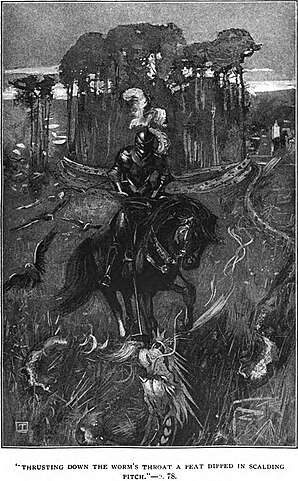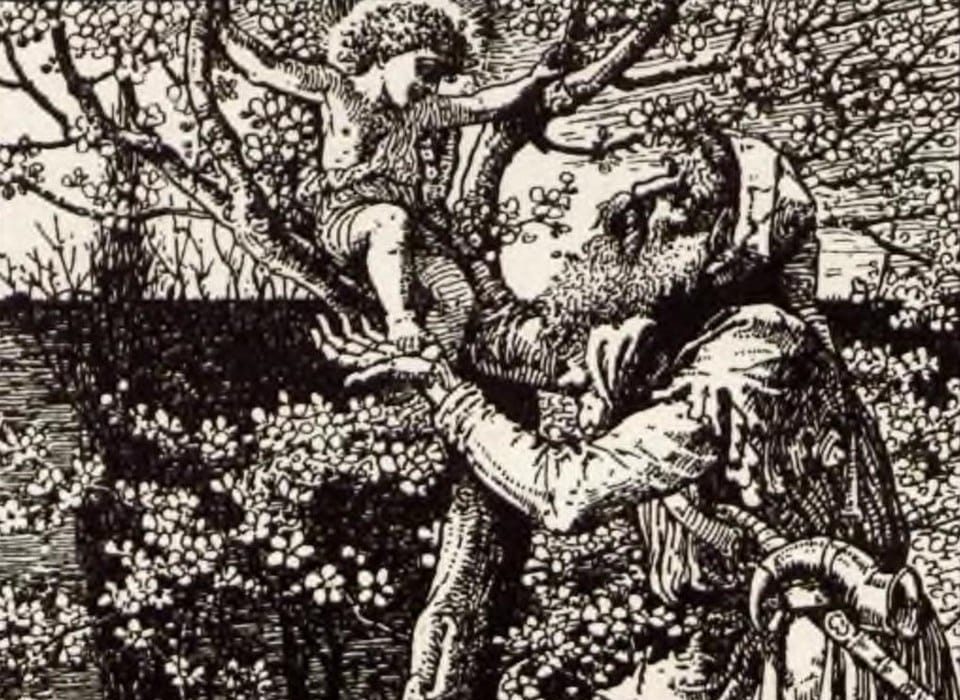The Border Legends of Scotland made famous by Sir Walter Scott are deep within Scottish folklore. These stories permeate not just there, however. They also contribute to English folklore, and the stories of “worms” have made their way into the fantasy realm (e.g. as dragons). In addition to this, a Border Legend of Scotland imparts some bit of Scottish Heritage. In this post, we are going to examine some of the Border Legends of Scotland.
The Worme of Linton
The Horrid Beast
The first Border Legend of Scotland details the struggles of a knight overcoming a beast. The story of The Worme of Linton begins thusly: The Worme of Linton was a horribly massive worm-like creature that could breath fire and sprout wings. As the tales went, it could devour men whole and demolish entire villages. For the local populace, this was a terrifying affair.
The worm lived in Linton, Roxburghshire, and was active around the 1100s. Apparently, it would terrorize farmers by eating their sheep and forcing them to rethink their labors.
“Quite naturally, the people of Linton were thrown into a collective state of fear when the slithering thing decided to target their little village,” states Nick Redfurn in an article for Mysterious Universe. “People became petrified to leave their homes, lest they became the victims of the marauding beast.”
The Knight John Sommerville.
John Sommerville, who was looking for fame at this time, was both brave and had honor. So, he headed out to defeat the Worm of Linton for his own namesake.
Upon entering the vicinity of the worm, the noble John Sommerville found a few things to be true: 1) there was a strange aura about the place, and 2) the worm had already impacted the town. If the noble Sommerville had not been nervous, certainly this gave him reason to be.
The town had emptied due to the worm’s presence, and the villagers migrated to nearby towns that were less bedeviled. After getting more stout directions from a lone blacksmith, Sommerville contracted the man to create a lance that could be set aflame. Then, after receiving the lance around sunset, he traveled to the lair of the worm.
Sommerville crept up to the den of the worm and found himself lying it wait for it to attack. He could hear it inside the cave, breathing deeply, and the occasional spout of flame emanated from the dark entrance. There were bones of cattle hither and thither, and Sommerville summoned all of his strength. Alerting the creature with a fearsome holler, the worm rose from the depths of its lair.
Ferociously, it came from the cave and charged Sommerville. However, Sommerville was no naive, and adequately defended himself from the creature’s attacks. They battled for a long time, the worm charging and swinging its tail, and Sommerville moving adeptly in his armor and parrying with his sword. the worm became enraged and fought harder, but Sommerville was a seasoned veteran. He stood his ground. When he knew he had the worm cornered, he set his spear aflame and charged the great swinging beats. He plunged the spear into the creature’s neck and though it fought back by wriggling and writhing, it soon fell to death.
Sommerville had won. Afterward, the people who celebrated his story carved his image into the Linton Church. He was also given a title, and the town was relieved of their worm for good.
The Brownie’s Coat
The second Border Legend of Scotland is about a mysterious household helper. We often don’t think of creatures and ghosts as being particularly helpful, but the Brownie of Scotland happens to be one of those beneficial intruders. Most of the time.
The Brownie of England can be described as an unkempt and short creature that is quick and crafty. Yet, it upsets easy and can be quite shaggy in appearance at times. It does not like to be around humans and often spends its time completing chores for the family they live with. From the shadows, their service is performed.
A popular story regarding the Brownie features an ailing wife, perhaps in the throes of sickness or in labor. In the story, she would not allow her husband to traverse a storm in the middle of the night to fetch the mid-wife. Instead, she sends an errant servant who failed spectacularly in his task by not even attempting the voyage. The Brownie instead took it upon himself to venture to the town to ensure that he would have a well-kept home on his return. While Brownies are selfish creatures, they do look after their own. On the journey, the Brownie took along with him a large coat to keep him warm during his travels.
Indeed, the creature did return with the mid-wife and made sure to punish the errant servant with a flogging. In return, the Brownie simply expected what all Brownies expect–only to be rewarded with food placed by the hearth. The family did just that and the man of the house, having heard of the Brownie’s good deed, gifted him a coat of his own. Then the Brownie left, never to be heard from again.
Conclusion
In both of these Border Legends of Scotland, one cand find Scottish legend and history. The noble knight who trounces a dragon appears in many cultures. The Worme of Linton, as it is, teaches the Scottish people of courage, resourcefulness, and standing one’s ground. Meanwhile, a noble, but annoyed, spirit that helps families in times of strife (e.g. the Brownie) informs Scottish people of humility, gratitude, and the value of unseen labor.





Leave a comment